Maintenance document RENAULT KOLEOS 2015 1.G Owners Manual
[x] Cancel search | Manufacturer: RENAULT, Model Year: 2015, Model line: KOLEOS, Model: RENAULT KOLEOS 2015 1.GPages: 232, PDF Size: 18.18 MB
Page 58 of 232
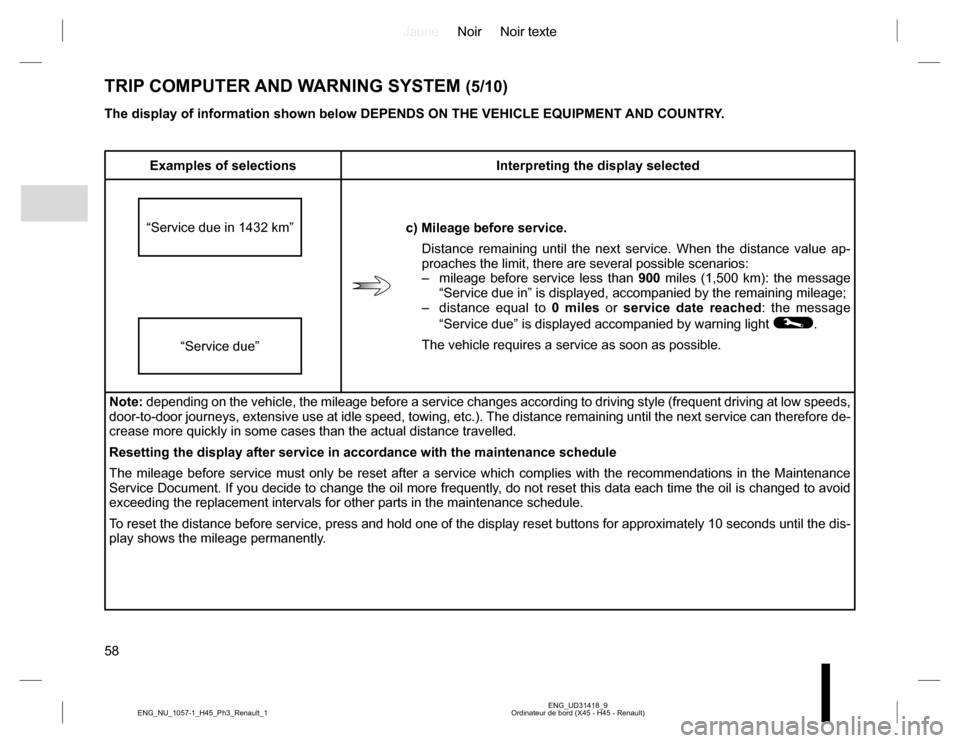
JauneNoir Noir texte
58
ENG_UD31418_9
Ordinateur de bord (X45 - H45 - Renault) ENG_NU_1057-1_H45_Ph3_Renault_1
TRIP COMPUTER AND WARNING SYSTEM (5/10)
Examples of selections Interpreting the display selected
c) Mileage before service.
Distance remaining until the next service. When the distance value ap-
proaches the limit, there are several possible scenarios:
– mileage before service less than 900 miles (1,500 km): the message
“Service due in” is displayed, accompanied by the remaining mileage;
– distance equal to 0 miles or service date reached: the message
“Service due” is displayed accompanied by warning light
©.
The vehicle requires a service as soon as possible. “Service due in 1432 km”
“Service due”
Note: depending on the vehicle, the mileage before a service changes according to driving style (frequent driving at low speeds,
door-to-door journeys, extensive use at idle speed, towing, etc.). The distance remaining until the next service can therefore de-
crease more quickly in some cases than the actual distance travelled.
Resetting the display after service in accordance with the maintenance schedule
The mileage before service must only be reset after a service which complies with the recommendations in the Maintenance
Service Document. If you decide to change the oil more frequently, do not reset this data each time the oil is changed to avoid
exceeding the replacement intervals for other parts in the maintenance schedule.
To reset the distance before service, press and hold one of the display reset buttons for approximately 10 seconds until the dis-
play shows the mileage permanently. The display of information shown below DEPENDS ON THE VEHICLE EQUIPMENT AND COUNTRY.
Page 78 of 232
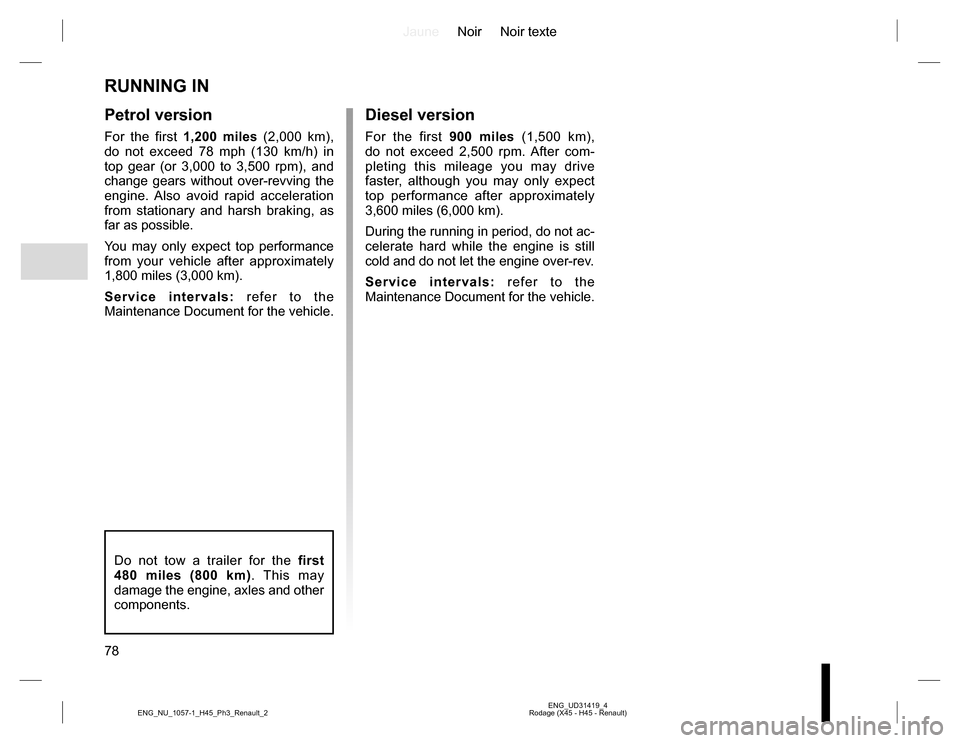
JauneNoir Noir texte
78
ENG_UD31419_4
Rodage (X45 - H45 - Renault) ENG_NU_1057-1_H45_Ph3_Renault_2
RUNNING IN
Petrol version
For the first 1,200 miles (2,000 km),
do not exceed 78 mph (130 km/h) in
top gear (or 3,000 to 3,500 rpm), and
change gears without over-revving the
engine. Also avoid rapid acceleration
from stationary and harsh braking, as
far as possible.
You may only expect top performance
from your vehicle after approximately
1,800 miles (3,000 km).
Service intervals: refer to the
Maintenance Document for the vehicle.
Diesel version
For the first 900 miles (1,500 km),
do not exceed 2,500 rpm. After com-
pleting this mileage you may drive
faster, although you may only expect
top performance after approximately
3,600 miles (6,000 km).
During the running in period, do not ac-
celerate hard while the engine is still
cold and do not let the engine over-rev.
Service intervals: refer to the
Maintenance Document for the vehicle.
Do not tow a trailer for the first
480 miles (800 km). This may
damage the engine, axles and other
components.
Page 82 of 232
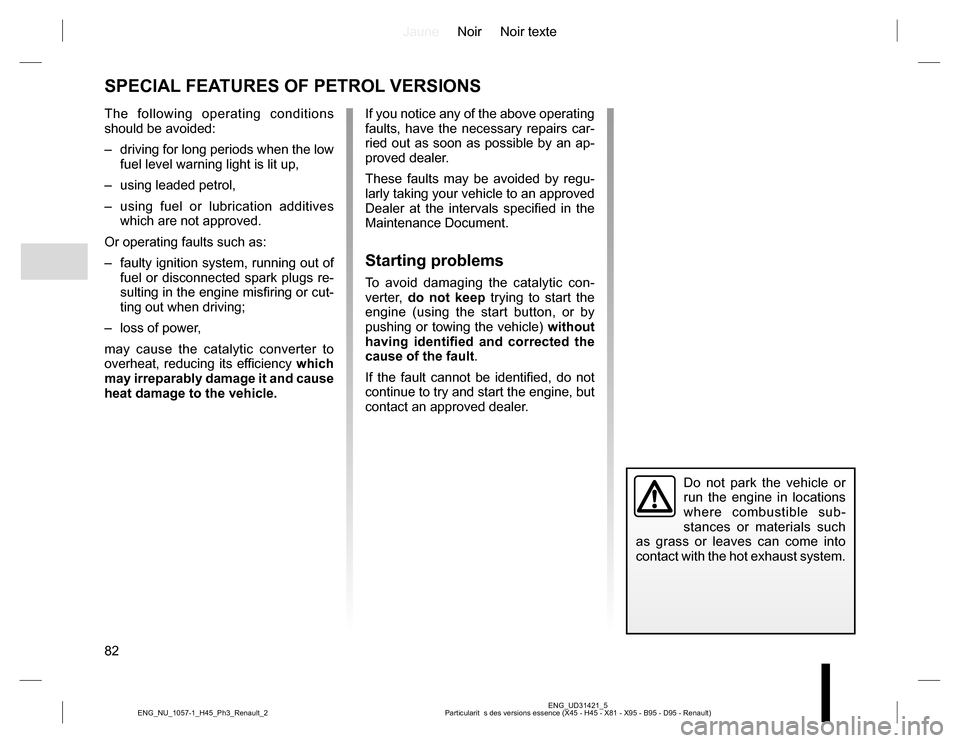
JauneNoir Noir texte
82
ENG_UD31421_5
Particularit s des versions essence (X45 - H45 - X81 - X95 - B95 - D95 - Renault) ENG_NU_1057-1_H45_Ph3_Renault_2
SPECIAL FEATURES OF PETROL VERSIONS
Do not park the vehicle or
run the engine in locations
where combustible sub-
stances or materials such
as grass or leaves can come into
contact with the hot exhaust system.
The following operating conditions
should be avoided:
– driving for long periods when the low
fuel level warning light is lit up,
– using leaded petrol,
– using fuel or lubrication additives
which are not approved.
Or operating faults such as:
– faulty ignition system, running out of
fuel or disconnected spark plugs re-
sulting in the engine misfiring or cut-
ting out when driving;
– loss of power,
may cause the catalytic converter to
overheat, reducing its efficiency which
may irreparably damage it and cause
heat damage to the vehicle.If you notice any of the above operating
faults, have the necessary repairs car-
ried out as soon as possible by an ap-
proved dealer.
These faults may be avoided by regu-
larly taking your vehicle to an approved
Dealer at the intervals specified in the
Maintenance Document.
Starting problems
To avoid damaging the catalytic con-
verter, do not keep trying to start the
engine (using the start button, or by
pushing or towing the vehicle) without
having identified and corrected the
cause of the fault.
If the fault cannot be identified, do not
continue to try and start the engine, but
contact an approved dealer.
Page 133 of 232
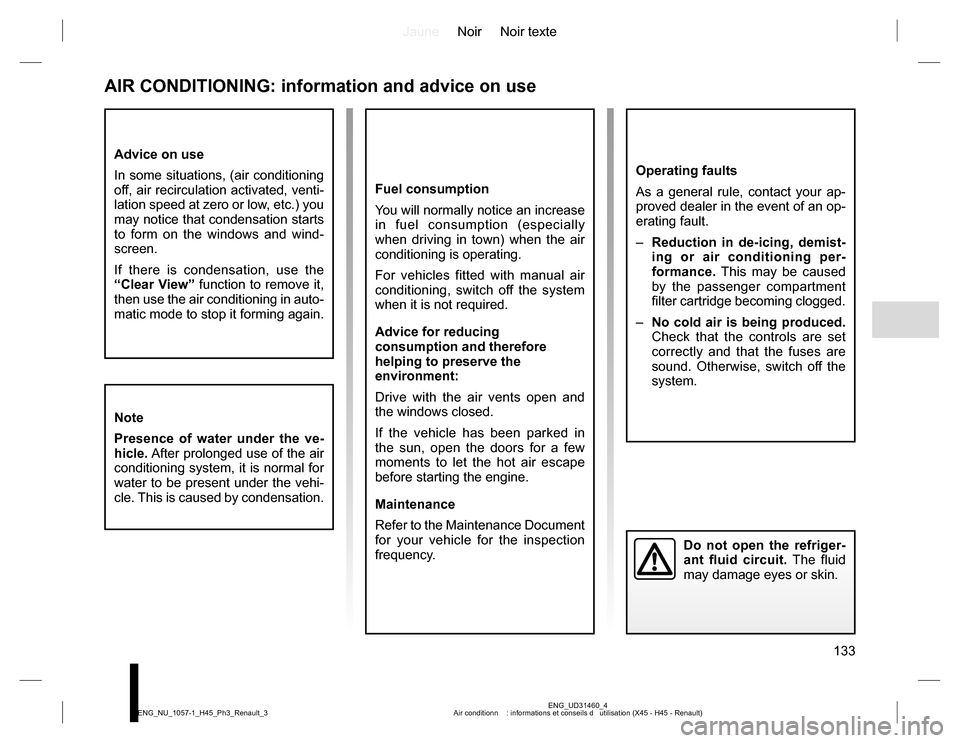
JauneNoir Noir texte
133
ENG_UD31460_4
Air conditionn : informations et conseils d utilisation (X45 - H45 - Renault) ENG_NU_1057-1_H45_Ph3_Renault_3
AIR CONDITIONING: information and advice on use
Fuel consumption
You will normally notice an increase
in fuel consumption (especially
when driving in town) when the air
conditioning is operating.
For vehicles fitted with manual air
conditioning, switch off the system
when it is not required.
Advice for reducing
consumption and therefore
helping to preserve the
environment:
Drive with the air vents open and
the windows closed.
If the vehicle has been parked in
the sun, open the doors for a few
moments to let the hot air escape
before starting the engine.
Maintenance
Refer to the Maintenance Document
for your vehicle for the inspection
frequency.
Operating faults
As a general rule, contact your ap-
proved dealer in the event of an op-
erating fault.
– Reduction in de-icing, demist-
ing or air conditioning per-
formance. This may be caused
by the passenger compartment
filter cartridge becoming clogged.
– No cold air is being produced.
Check that the controls are set
correctly and that the fuses are
sound. Otherwise, switch off the
system.
Advice on use
In some situations, (air conditioning
off, air recirculation activated, venti-
lation speed at zero or low, etc.) you
may notice that condensation starts
to form on the windows and wind-
screen.
If there is condensation, use the
“Clear View” function to remove it,
then use the air conditioning in auto-
matic mode to stop it forming again.
Do not open the refriger-
ant fluid circuit. The fluid
may damage eyes or skin.
Note
Presence of water under the ve-
hicle. After prolonged use of the air
conditioning system, it is normal for
water to be present under the vehi-
cle. This is caused by condensation.
Page 163 of 232
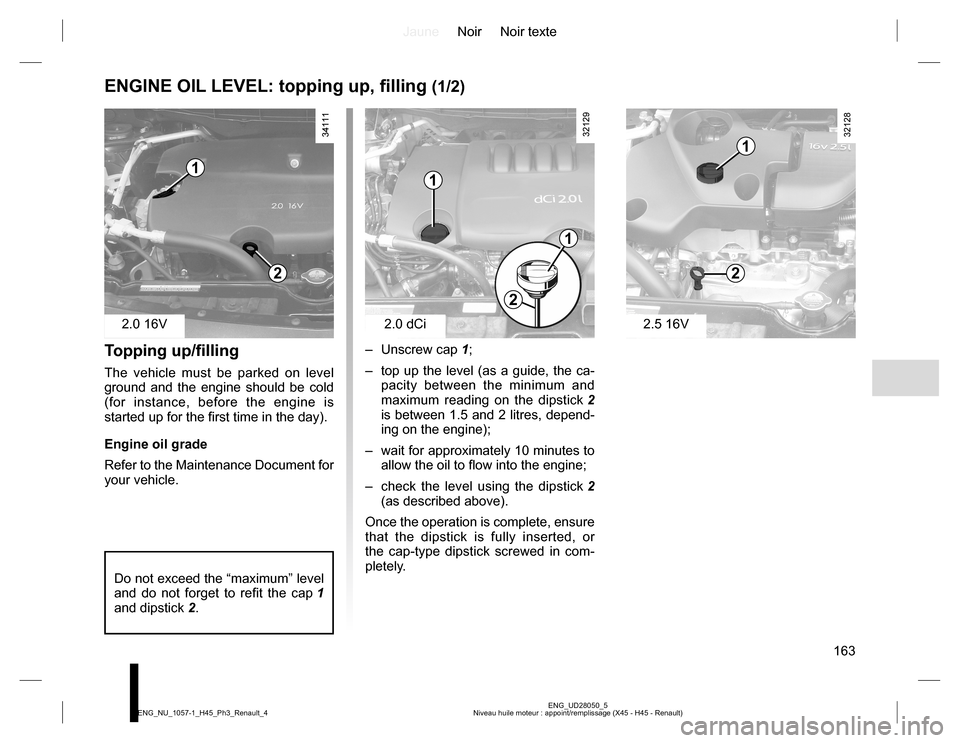
JauneNoir Noir texte
163
ENG_UD28050_5
Niveau huile moteur : appoint/remplissage (X45 - H45 - Renault) ENG_NU_1057-1_H45_Ph3_Renault_4
ENGINE OIL LEVEL: topping up, filling (1/2)
Topping up/filling
The vehicle must be parked on level
ground and the engine should be cold
(for instance, before the engine is
started up for the first time in the day).
Engine oil grade
Refer to the Maintenance Document for
your vehicle.
– Unscrew cap 1;
– top up the level (as a guide, the ca-
pacity between the minimum and
maximum reading on the dipstick 2
is between 1.5 and 2 litres, depend-
ing on the engine);
– wait for approximately 10 minutes to
allow the oil to flow into the engine;
– check the level using the dipstick 2
(as described above).
Once the operation is complete, ensure
that the dipstick is fully inserted, or
the cap-type dipstick screwed in com-
pletely.
Do not exceed the “maximum” level
and do not forget to refit the cap 1
and dipstick 2.
1
2
1
2.0 dCi
1
2
2.0 16V2.5 16V
1
2
Page 164 of 232
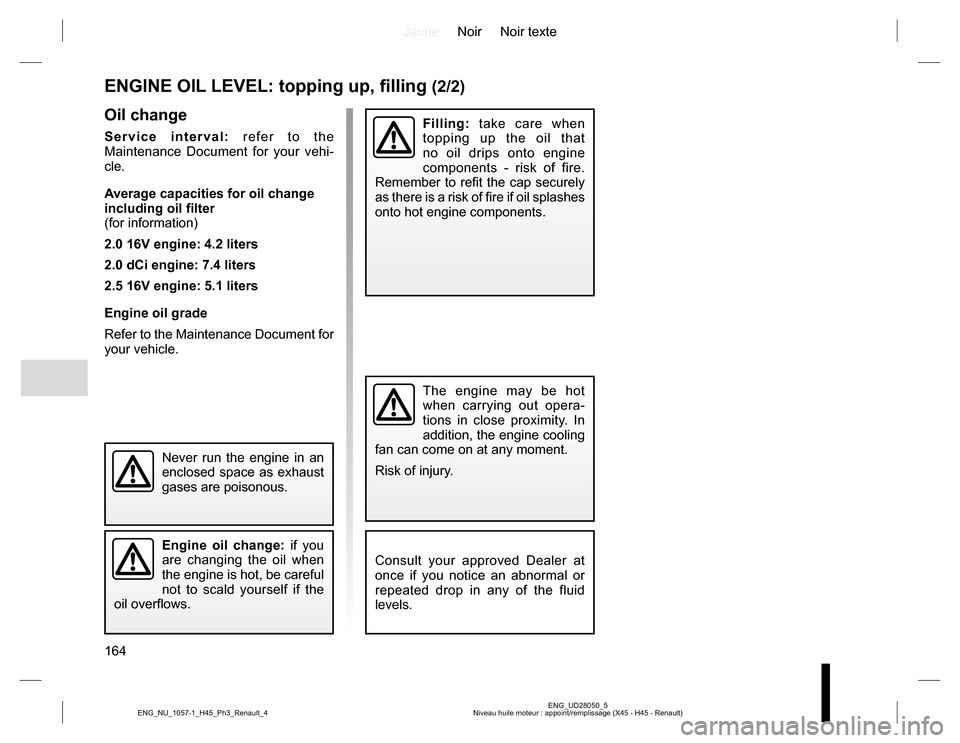
JauneNoir Noir texte
164
ENG_UD28050_5
Niveau huile moteur : appoint/remplissage (X45 - H45 - Renault) ENG_NU_1057-1_H45_Ph3_Renault_4
Oil change
Service interval: refer to the
Maintenance Document for your vehi-
cle.
Average capacities for oil change
including oil filter
(for information)
2.0 16V engine: 4.2 liters
2.0 dCi engine: 7.4 liters
2.5 16V engine: 5.1 liters
Engine oil grade
Refer to the Maintenance Document for
your vehicle.
ENGINE OIL LEVEL: topping up, filling (2/2)
Consult your approved Dealer at
once if you notice an abnormal or
repeated drop in any of the fluid
levels.
Never run the engine in an
enclosed space as exhaust
gases are poisonous.
Filling: take care when
topping up the oil that
no oil drips onto engine
components - risk of fire.
Remember to refit the cap securely
as there is a risk of fire if oil splashes
onto hot engine components.
Engine oil change: if you
are changing the oil when
the engine is hot, be careful
not to scald yourself if the
oil overflows.
The engine may be hot
when carrying out opera-
tions in close proximity. In
addition, the engine cooling
fan can come on at any moment.
Risk of injury.
Page 165 of 232
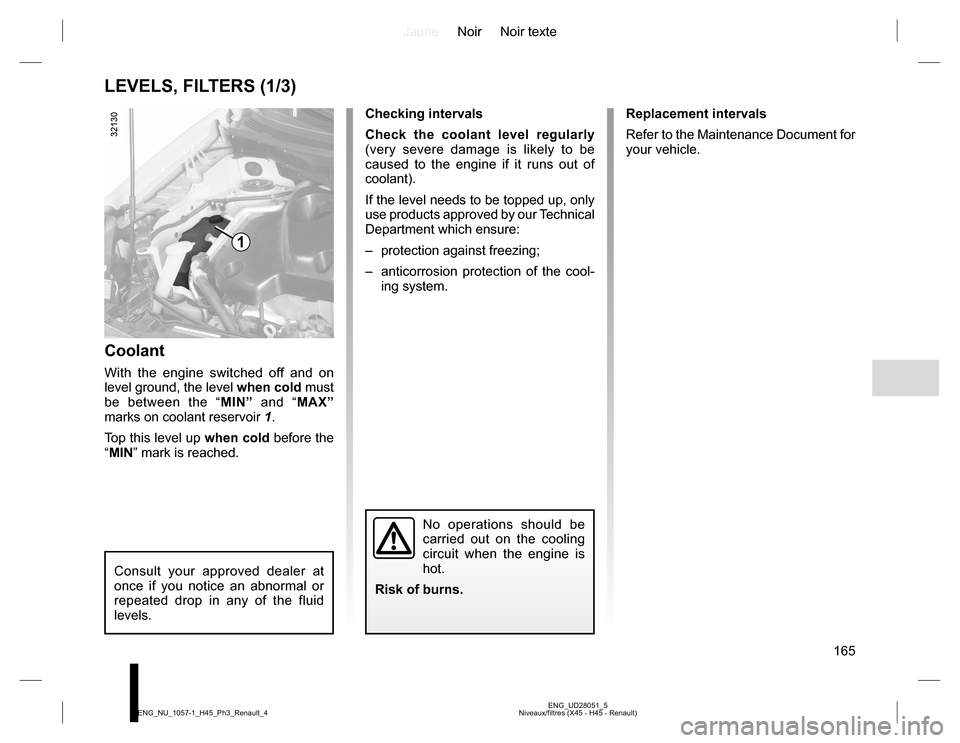
JauneNoir Noir texte
165
ENG_UD28051_5
Niveaux/filtres (X45 - H45 - Renault) ENG_NU_1057-1_H45_Ph3_Renault_4
LEVELS, FILTERS (1/3)
1
Coolant
With the engine switched off and on
level ground, the level when cold must
be between the “MIN” and “MAX”
marks on coolant reservoir 1.
Top this level up when cold before the
“MIN” mark is reached.Checking intervals
Check the coolant level regularly
(very severe damage is likely to be
caused to the engine if it runs out of
coolant).
If the level needs to be topped up, only
use products approved by our Technical
Department which ensure:
– protection against freezing;
– anticorrosion protection of the cool-
ing system.Replacement intervals
Refer to the Maintenance Document for
your vehicle.
No operations should be
carried out on the cooling
circuit when the engine is
hot.
Risk of burns.
Consult your approved dealer at
once if you notice an abnormal or
repeated drop in any of the fluid
levels.
Page 166 of 232
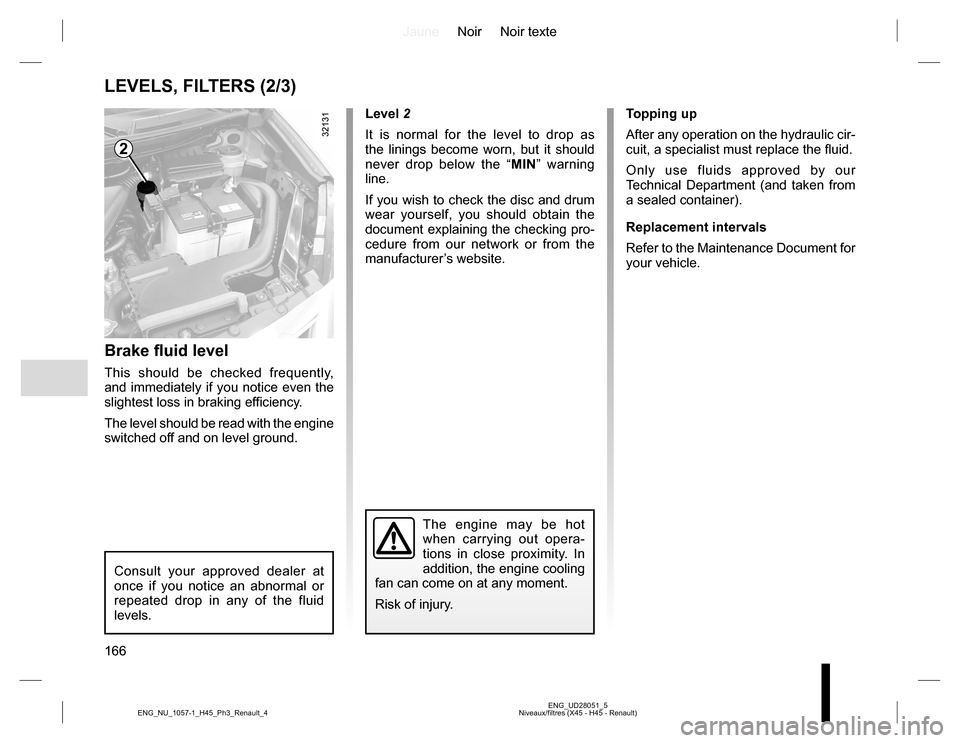
JauneNoir Noir texte
166
ENG_UD28051_5
Niveaux/filtres (X45 - H45 - Renault) ENG_NU_1057-1_H45_Ph3_Renault_4
LEVELS, FILTERS (2/3)
2
Brake fluid level
This should be checked frequently,
and immediately if you notice even the
slightest loss in braking efficiency.
The level should be read with the engine
switched off and on level ground.Level 2
It is normal for the level to drop as
the linings become worn, but it should
never drop below the “MIN” warning
line.
If you wish to check the disc and drum
wear yourself, you should obtain the
document explaining the checking pro-
cedure from our network or from the
manufacturer’s website.Topping up
After any operation on the hydraulic cir-
cuit, a specialist must replace the fluid.
Only use fluids approved by our
Technical Department (and taken from
a sealed container).
Replacement intervals
Refer to the Maintenance Document for
your vehicle.
The engine may be hot
when carrying out opera-
tions in close proximity. In
addition, the engine cooling
fan can come on at any moment.
Risk of injury.
Consult your approved dealer at
once if you notice an abnormal or
repeated drop in any of the fluid
levels.
Page 167 of 232
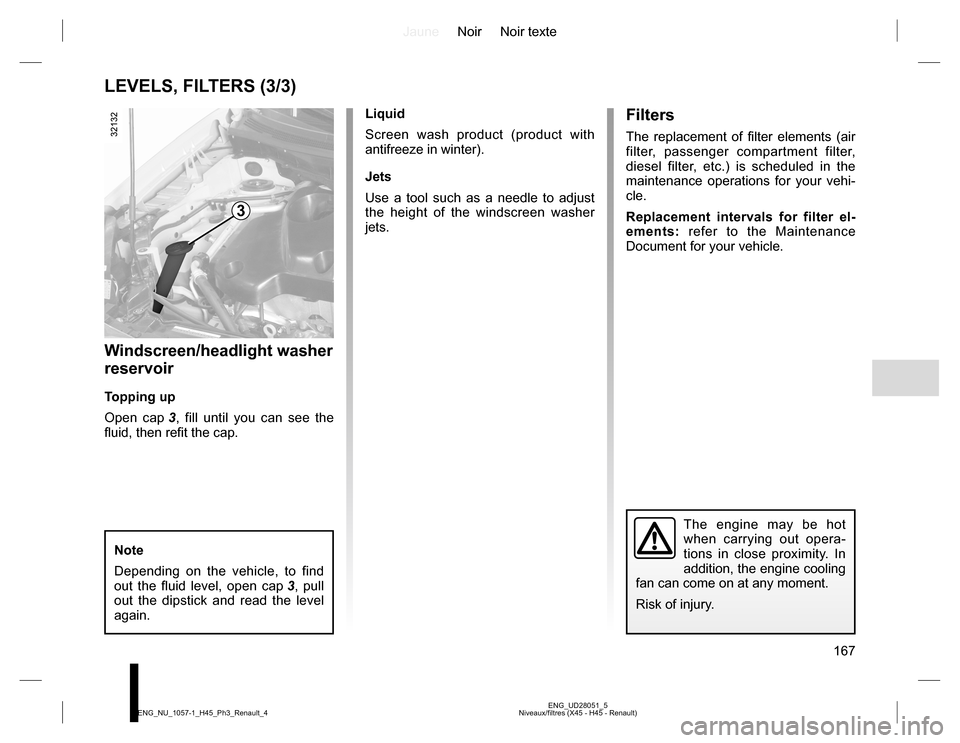
JauneNoir Noir texte
167
ENG_UD28051_5
Niveaux/filtres (X45 - H45 - Renault) ENG_NU_1057-1_H45_Ph3_Renault_4
LEVELS, FILTERS (3/3)
Note
Depending on the vehicle, to find
out the fluid level, open cap 3, pull
out the dipstick and read the level
again.
3
Windscreen/headlight washer
reservoir
Topping up
Open cap 3, fill until you can see the
fluid, then refit the cap.Liquid
Screen wash product (product with
antifreeze in winter).
Jets
Use a tool such as a needle to adjust
the height of the windscreen washer
jets.
Filters
The replacement of filter elements (air
filter, passenger compartment filter,
diesel filter, etc.) is scheduled in the
maintenance operations for your vehi-
cle.
Replacement intervals for filter el-
ements: refer to the Maintenance
Document for your vehicle.
The engine may be hot
when carrying out opera-
tions in close proximity. In
addition, the engine cooling
fan can come on at any moment.
Risk of injury.
Page 171 of 232
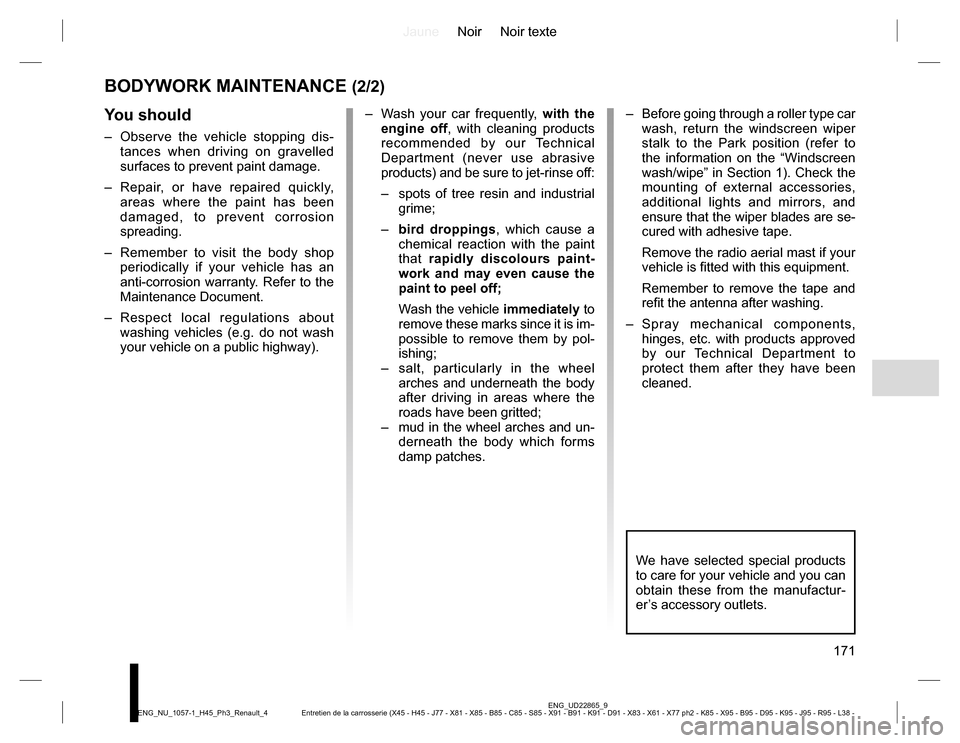
JauneNoir Noir texte
171
ENG_UD22865_9
Entretien de la carrosserie (X45 - H45 - J77 - X81 - X85 - B85 - C85 - S85 - X91 - B91 - K91 - D91 - X83 - X61 - X77 ph2 - K85 - X95 - B95 - D95 - K95 - J95 - R95 - L38 - ENG_NU_1057-1_H45_Ph3_Renault_4
– Before going through a roller type car
wash, return the windscreen wiper
stalk to the Park position (refer to
the information on the “Windscreen
wash/wipe” in Section 1). Check the
mounting of external accessories,
additional lights and mirrors, and
ensure that the wiper blades are se-
cured with adhesive tape.
Remove the radio aerial mast if your
vehicle is fitted with this equipment.
Remember to remove the tape and
refit the antenna after washing.
– Spray mechanical components,
hinges, etc. with products approved
by our Technical Department to
protect them after they have been
cleaned.
BODYWORK MAINTENANCE (2/2)
We have selected special products
to care for your vehicle and you can
obtain these from the manufactur-
er’s accessory outlets.
You should
– Observe the vehicle stopping dis-
tances when driving on gravelled
surfaces to prevent paint damage.
– Repair, or have repaired quickly,
areas where the paint has been
damaged, to prevent corrosion
spreading.
– Remember to visit the body shop
periodically if your vehicle has an
anti-corrosion warranty. Refer to the
Maintenance Document.
– Respect local regulations about
washing vehicles (e.g. do not wash
your vehicle on a public highway).– Wash your car frequently, with the
engine off, with cleaning products
recommended by our Technical
Department (never use abrasive
products) and be sure to jet-rinse off:
– spots of tree resin and industrial
grime;
– bird droppings, which cause a
chemical reaction with the paint
that rapidly discolours paint-
work and may even cause the
paint to peel off;
Wash the vehicle immediately to
remove these marks since it is im-
possible to remove them by pol-
ishing;
– salt, particularly in the wheel
arches and underneath the body
after driving in areas where the
roads have been gritted;
– mud in the wheel arches and un-
derneath the body which forms
damp patches.